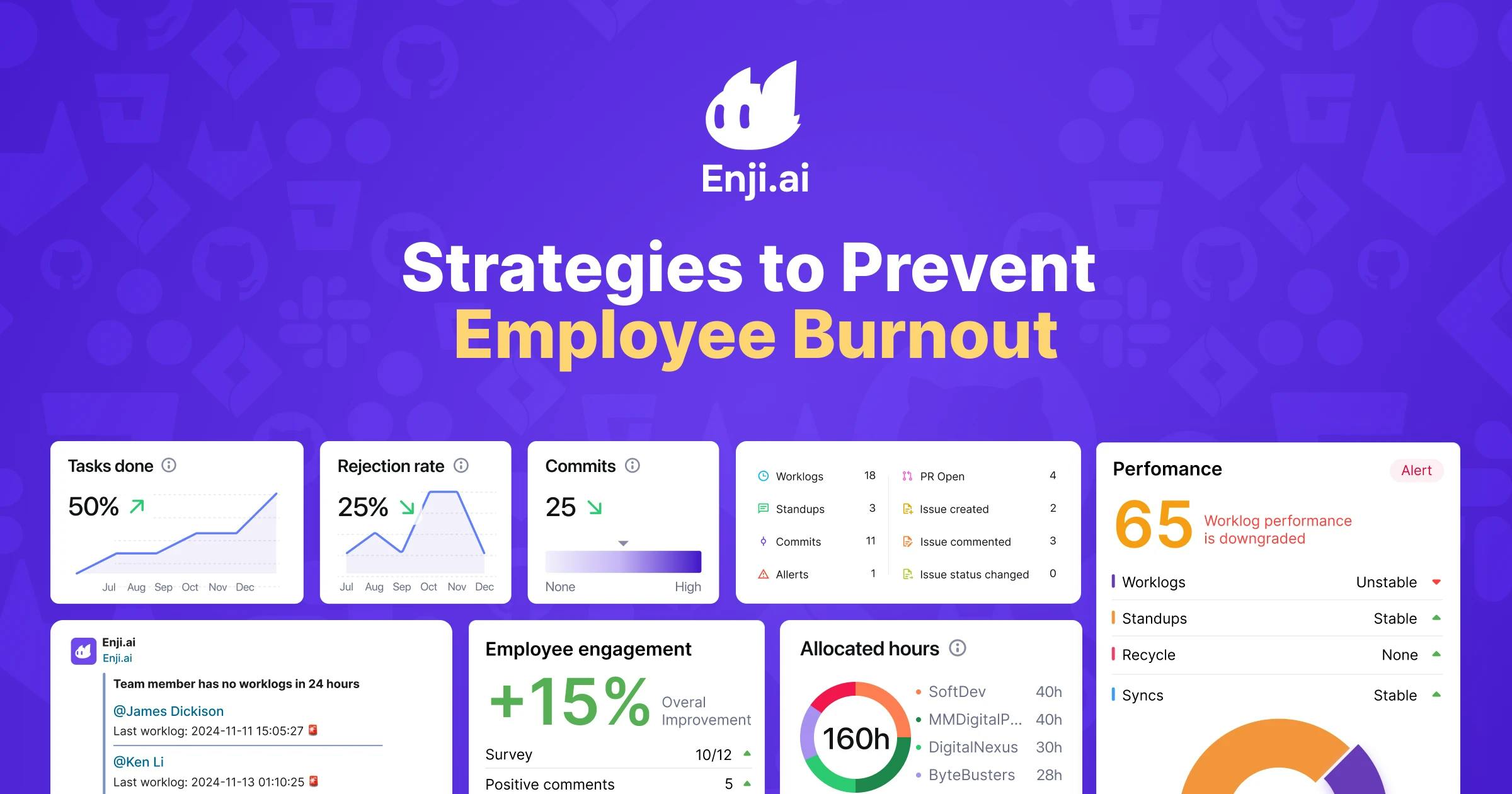Strategies to Prevent Employee Burnout and Build a Positive Mental Health Environment

There are various causes of low productivity, from ineffective instruments to processes that create roadblocks. Another factor that contributes to poor performance is employee burnout. When individuals lack the physical energy and inner motivation to work at their best, companies, clients, and products suffer.
This article will explore employee burnout's effects on businesses, explain its causes, and offer strategies for developing a positive working environment. From top management to junior employees, everyone can benefit from these best practices because they aim to improve business processes across a company.
Employee burnout
The World Health Organization (WHO) recognizes burnout as an "occupational phenomenon" that involves a general feeling of dissatisfaction with one's work, accompanied by mental, physical, and emotional exhaustion. At the core of this state is workplace stress which has not been properly managed. The presence of stress at work is not bad, and avoiding it completely is futile, especially where a team of individuals is involved. Add clients and management to the mix, and the employees of any business will experience a form of stressful work. This is why stress management is a critical factor in determining how employees act and continue to perform in stressful conditions.
Effects of burnout
According to WHO employee burnout statistics, individuals who experience this condition and leave it untreated risk more serious mental health consequences in the future. For businesses, the cost is also high, with an estimated 12 billion working days lost every year to depression and anxiety at a cost of $1 trillion dollars per year.
Symptoms of burnout
To avoid burnout, it is important to know the signs to identify employees experiencing it and for individuals to recognize the symptoms in their own behavior.
- Lack of energy and enthusiasm for work
- Cynical attitude towards colleagues and company
- Reduced productivity
- Mood swings, including aggression
An employee suffering from unmanaged work stress will show physical signs of burnout; however, relying only on visible manifestations is risky. Large companies and teams may not have enough managers to work with employees individually, and the popularity of hybrid and remote formats means colleagues do not see each other except for a face during a video call. Furthermore, physical signs of burnout may occur only in the later stages, when an employee has already made the decision to leave the company or work less.
Fortunately, data on employee activities can fill in the blanks and highlight the symptoms of burnout before they become serious. The extra time allows managers to adjust schedules and discuss other changes to improve the working environment. This article will explore data related to employee activity later. With an understanding of how to recognize burnout, it is time to learn what causes employees to experience it.
Causes of employee burnout
The underlying causes vary depending on the industry; however, there are common situations that will increase the chance of an employee experiencing burnout:
- Skills left unused or unrecognized: Even lack of work and especially unfulfilling work can lead to stress.
- Long working hours: Work that conflicts with personal plans and non-work obligations creates pressure on an individual.
- Understaffing: Without enough employees, others must work more and take on more responsibilities.
- Negative workplace culture: When colleagues do not actively support each other, or managers reward privileged employees for poor performance.
- Excessive micromanagement: Guidance is helpful, but constant check-ins or corrections reduce productivity and increase friction between individuals.
- Lack of clarity in role and tasks: The need to regularly ask what needs to be done leads to wasted time and a lack of motivation in work.
- Unclear or low career perspectives and professional development: Employees who lack direction, professional support, and an adequate salary will begin to lose a reason to perform well.
- Conflicting professional and personal demands: While not always something employers can control, employees can experience situations when they feel theey must choose between commitments at home and work.
To reduce the risk of employee burnout, companies can use these causes as a roadmap and create working environments that provide better hours and lead to more employee satisfaction. There are, however, certain aspects that are not covered in this list.
10 strategies to prevent employee burnout
As mentioned earlier, employee burnout is dangerous for individuals, teams, and businesses. Similar to other potential risks a company faces, management can decide to invest in the long-term improvement of the mental health of its workforce or ignore it until the risk becomes an immediate threat to productivity. This requires focusing financial and human resources away from a product and diverting them to managing stress to boost performance and value creation over time. Here are 10 best practices that businesses can employ to create anti-burnout working environments:
1. Clear communication
In many ways, the causes of burnout are all linked to a lack of communication between employers and employees. Both sides need to express their expectations and limitations to avoid any misunderstandings and situations where employees experience fatigue and decreased motivation. This involves creating a transparent culture where honesty does not result in punishment.
2. Mental health awareness
Businesses can make burnout prevention a priority by raising awareness through materials and training. Informing mid-level managers about the symptoms and how to develop strategies to boost employee motivation and inclusion are central aspects of such a strategy. Likewise, it is the responsibility of individual employees to understand when they need a break and how to effectively rest and recharge.
3. Active monitoring of employee data
The symptoms listed in this article are helpful in recognizing burnout, but they may appear too late. Through data analysis, businesses can understand when an employee may be experiencing challenges in their work or not performing due to too many hours or inefficient processes.
4. Organize breaks
Some companies require employees to submit worklogs that detail what they did for a certain amount of time. One strategy to encourage breaks is to arrange recommendations on the maximum time for a worklog, such as two hours. For example, a task may require six hours to complete, but employees can only work on it for two hours at a time, after which they should take a break.
5. Recognize high performance
Ensure that employees' contributions to a team and business are acknowledged and rewarded with bonuses or other awards. Without this, individuals may think that their work does not matter, which in turn leads to decisions to reduce their effort or leave a company.
6. Manage employee workload
Business and team managers need to be flexible and understand when circumstances change, either for an individual employee or a team. When a workload only increases hours and not performance, people will become tired and develop symptoms of burnout.
7. Automate routine tasks
Employees want to perform interesting tasks, create interesting and valuable products, and make contributions to a team or project. Automating tasks, such as moving and assigning work in a task manager or creating reports, gives individuals more time to focus on fulfilling work where they can apply their unique skills.
8. Provide more autonomy
Employees want to perform well and experience the trust of their managers. Part of recognizing achievement and quality work involves less micromanagement and more trust that individuals know what to do and how to complete tasks. This helps employees feel fulfilled and reduces stress on managers.
9. Define clear career advancement opportunities
Businesses use goals and targets to align their work and drive performance; the same logic applies to individuals. Employees who understand what they can achieve in a company and in what timeframe will feel motivated to excel at their work. They know what they can accomplish.
10. Consider flexible working arrangements
Some businesses can achieve the same level of performance without requiring employees to be present at an office for eight hours every day of the week. If possible, allow individuals to work out of the office to give them more flexibility and create a better work-life balance. These arrangements could involve hybrid or remote work options.
Enji's Employee Pulse: an anti-burnout tool
If businesses monitor employee performance data, managers and leaders can notice when individuals and teams begin to experience the symptoms of burnout. Employees produce an incredible amount of data, and the challenge of collecting and analyzing it is real. That is why Enji gathers data in the background without interrupting anyone's work or redirecting resources away from important tasks.
Enji's Employee Pulse feature analyzes data employees create, such as worklogs, task comments and status changes, and stand-ups, to identify trends related to burnout. Here is an example:
Anna typically logs 7-8 hours of work a day during the week. After six months of work at the company, she begins to submit worklogs that total around 6-7 hours, and those begin to decline to 5-6 hours each week. She completes tasks, but they take a bit longer to complete than before, and Anna does not reply as quickly to comments and messages.
Is Anna experiencing burnout? It is impossible to say, but Enji's Employee Pulse will notice the trends in her work performance and alert the manager responsible for her team or project. Further investigation may show that Anna has not had a one-on-one meeting with her manager in a couple of months. It may show that she has been given more challenging tasks. The metrics Employee Pulse analyzes are signals that leadership can use to learn more about Anna's situation and make adjustments to her workload.
Enji and employee health
Management can employ Enji to ensure the effective application of the strategies mentioned above. Together with Employee Pulse, the platform offers several other exceptional features that promote a positive work environment:
- Continuous monitoring: Enji collects and analyzes data 24/7 in the background so that employees can focus on their work.
- Clear communication: The Asynchronous stand-ups, PM Agent, and Summarizer features create a transparent environment where everyone gets the information they need.
- Creating breaks: Configure Enji's alerts to remind employees to take breaks from tasks and send signals to managers when team members have not logged their time.
- Recognize high performance: The Employee Profits, Stand-ups, and Worklogs features keep leadership informed about which team members are contributing the most to the company's performance.
- Manage workload: Enji's project and Scope of Work dashboards for managers compare expected and actual hours so that employees do not overwork or underwork. Enji promotes flexibility and helps leaders find other team members to support their colleagues.
- Automation: Enji's bots and alerts help teams automate their routine reminders and reports to allow employees to focus on meaningful and important tasks.
- Promote autonomy: Managers can use Enji's alerts and reminders to guide team members to follow efficient and transparent processes without meetings and micromanagement.
- Hybrid and remote team support: Enji aims to boost the performance of remote teams. Through asynchronous communication and other features, the platform helps managers and team members stay connected and maintain high-quality work.
Leaders and teams throughout a company reap the benefits of Enji. C-level managers can plan with objective data and know their available resources, middle management will improve interactions with team members and boost project planning, and HR teams can track employee activity to ensure that a business's culture reduces employee burnout.
Healthy performance with Enji
Enji helps businesses create a positive working environment for employees at all levels of the organization, from top management to new employees, because burnout can affect anyone. The key is to develop processes that encourage transparency and accountability.

The Enji team is ready to learn about any company that wants to start performing better today and to share more about how the platform can promote an anti-burnout workplace culture.



